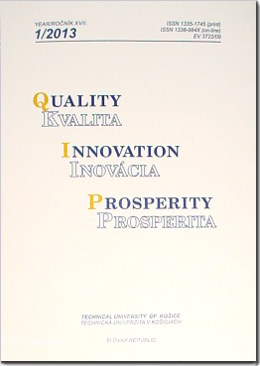Abstract
Full text article
References
Berry, L. L., Parasuraman, A., 1991. Marketing services: Competing through quality. New York: The Free Press.
Bowen, J. T., Shoemaker, S., 2003. Loyalty: A strategic commitment. Cornell Hotel and Restaurant Administration Quarterly, 44(5/6), p. 31−46.
Brody, Robert P., Cunningham, Scott M., 1968, Personality variables and the consumer decision process. Journal of Marketing Research.
Cater, B., Zabkar, V., 2009. Antecedents and consequences of commitment in marketing research services: The client's perspective. Industrial Marketing Management, 38(7), p. 785−797.
de Ruyter, K., Moorman, L., Lemmink, J. 2001. Antecedents of commitment and trust in customer–supplier relationships in high technology markets. Industrial Marketing Management, 30(3), p. 271−286.
EFQM, 2010. Improvement feedback in real time: the Net Promoter Score at Nokia. <http://www.efqm.org/en/newsletter/> [Accessed 2nd of September 2010].
EFQM, 2013. EFQM Excellence Model. Brussels: EFQM. 2013, 29 p.
Ehrenberg, A. 1988. Repeat buying: Theory and applications (2nd edition). London: Charles Griffin & Co.
Evanschitzky, H., Iyer, G. R., Plassmann, H., Niessing, J., & Meffert, H., 2006. The relative strength of affective commitment in securing loyalty in service relationships. Journal of Business Research, 59(12), p. 1207−1213.
Harrison-Walker, J. L. 2001. The measurement of word-of-mouth communication and an investigation of service quality and customer commitment as potential antecedents. Journal of Service Research, 4(1), p. 60−75.
Hayes, B. E. 2009. Beyond Ultimate Question. A Systematic Approach to Improve Customer Loyalty. Milwaukee: ASQ Quality Press, 396 p.
ISO, 2009. ISO Guide 73, Risk Management – Vocabulary. Geneve: ISO, 2009
ISO, 2011. ISO/TS 10004. Quality management – Customer satisfaction – guidelines for monitoring and measuring. Geneve: ISO. 2011
ISO, 9004. Managing for the sustained success of an organization – A quality management approach. Geneve: ISO. 2009
Jacoby, J., Kyner, D. B., 1973, Brand loyalty vs. repeat purchasing behavior. Journal of Marketing Research 10 (1), p. 1–9.
Kahn, B. E., Kalwani, M. U., Morrison, D. G. 1986. Measuring variety-seeking and reinforcement behaviors using panel data. Journal of Marketing Research, 23(2).
Oliver, R. L., 1997. Satisfaction: A behavioral perspective on the consumer. Boston: Irwin McGraw-Hill.
Rauyruen, P., Miller, K. E., 2007. Relationship quality as a predictor of B2B customer loyalty. Journal of Business Research, 60(1), p. 21−31.
Reichheld, F. 1996. The Loyalty Effect: The Hidden Force Behind Growth, Profit and Lasting Value. Harvard Business School Press, 352 p.
Smith, J. B., Barclay, D. W., 1999. Selling partner relationships: The role of interdependence and relative influence. Journal of Personal Selling & Sales Management, 19(4), p. 21−40.
Wetzels,M., de Ruyter, K., Van Birgelen, M., 1998. Marketing service relationships: The role of commitment. Journal of Business & Industrial Marketing, 13(4/5), p. 406−423.
Woo, K. -S., Ennew, C. T., 2004. Business-to-business relationship quality: An IMP interaction-based conceptualization and measurement. European Journal of Marketing, 38(9/10), p. 1252−1271.
Authors
This is an open access journal which means that all content is freely available without charge to the user or his/her institution. Users are allowed to read, download, copy, distribute, print, search, or link to the full texts of the articles in this journal without asking prior permission from the publisher or the author. This is in accordance with the BOAI definition of open access. This journal is licensed under a Creative Commons Attribution 4.0 License - http://creativecommons.org/licenses/by/4.0.
Authors who publish with the Quality Innovation Prosperity agree to the following terms:
- Authors retain copyright and grant the journal right of first publication with the work simultaneously licensed under a Creative Commons Attribution License that allows others to share the work with an acknowledgement of the work's authorship and initial publication in this journal.
- Authors are able to enter into separate, additional contractual arrangements for the non-exclusive distribution of the journal's published version of the work (e.g., post it to an institutional repository or publish it in a book), with an acknowledgement of its initial publication in this journal.
- Authors are permitted and encouraged to post their work online (e.g., in institutional repositories or on their website) prior to and during the submission process, as it can lead to productive exchanges, as well as earlier and greater citation of published work.


